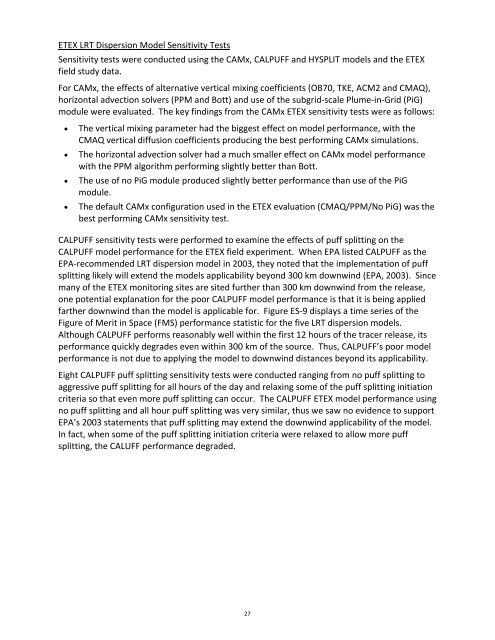Documentation of the Evaluation of CALPUFF and Other Long ...
Documentation of the Evaluation of CALPUFF and Other Long ...
Documentation of the Evaluation of CALPUFF and Other Long ...
You also want an ePaper? Increase the reach of your titles
YUMPU automatically turns print PDFs into web optimized ePapers that Google loves.
ETEX LRT Dispersion Model Sensitivity Tests<br />
Sensitivity tests were conducted using <strong>the</strong> CAMx, <strong>CALPUFF</strong> <strong>and</strong> HYSPLIT models <strong>and</strong> <strong>the</strong> ETEX<br />
field study data.<br />
For CAMx, <strong>the</strong> effects <strong>of</strong> alternative vertical mixing coefficients (OB70, TKE, ACM2 <strong>and</strong> CMAQ),<br />
horizontal advection solvers (PPM <strong>and</strong> Bott) <strong>and</strong> use <strong>of</strong> <strong>the</strong> subgrid‐scale Plume‐in‐Grid (PiG)<br />
module were evaluated. The key findings from <strong>the</strong> CAMx ETEX sensitivity tests were as follows:<br />
• The vertical mixing parameter had <strong>the</strong> biggest effect on model performance, with <strong>the</strong><br />
CMAQ vertical diffusion coefficients producing <strong>the</strong> best performing CAMx simulations.<br />
• The horizontal advection solver had a much smaller effect on CAMx model performance<br />
with <strong>the</strong> PPM algorithm performing slightly better than Bott.<br />
• The use <strong>of</strong> no PiG module produced slightly better performance than use <strong>of</strong> <strong>the</strong> PiG<br />
module.<br />
• The default CAMx configuration used in <strong>the</strong> ETEX evaluation (CMAQ/PPM/No PiG) was <strong>the</strong><br />
best performing CAMx sensitivity test.<br />
<strong>CALPUFF</strong> sensitivity tests were performed to examine <strong>the</strong> effects <strong>of</strong> puff splitting on <strong>the</strong><br />
<strong>CALPUFF</strong> model performance for <strong>the</strong> ETEX field experiment. When EPA listed <strong>CALPUFF</strong> as <strong>the</strong><br />
EPA‐recommended LRT dispersion model in 2003, <strong>the</strong>y noted that <strong>the</strong> implementation <strong>of</strong> puff<br />
splitting likely will extend <strong>the</strong> models applicability beyond 300 km downwind (EPA, 2003). Since<br />
many <strong>of</strong> <strong>the</strong> ETEX monitoring sites are sited fur<strong>the</strong>r than 300 km downwind from <strong>the</strong> release,<br />
one potential explanation for <strong>the</strong> poor <strong>CALPUFF</strong> model performance is that it is being applied<br />
far<strong>the</strong>r downwind than <strong>the</strong> model is applicable for. Figure ES‐9 displays a time series <strong>of</strong> <strong>the</strong><br />
Figure <strong>of</strong> Merit in Space (FMS) performance statistic for <strong>the</strong> five LRT dispersion models.<br />
Although <strong>CALPUFF</strong> performs reasonably well within <strong>the</strong> first 12 hours <strong>of</strong> <strong>the</strong> tracer release, its<br />
performance quickly degrades even within 300 km <strong>of</strong> <strong>the</strong> source. Thus, <strong>CALPUFF</strong>’s poor model<br />
performance is not due to applying <strong>the</strong> model to downwind distances beyond its applicability.<br />
Eight <strong>CALPUFF</strong> puff splitting sensitivity tests were conducted ranging from no puff splitting to<br />
aggressive puff splitting for all hours <strong>of</strong> <strong>the</strong> day <strong>and</strong> relaxing some <strong>of</strong> <strong>the</strong> puff splitting initiation<br />
criteria so that even more puff splitting can occur. The <strong>CALPUFF</strong> ETEX model performance using<br />
no puff splitting <strong>and</strong> all hour puff splitting was very similar, thus we saw no evidence to support<br />
EPA’s 2003 statements that puff splitting may extend <strong>the</strong> downwind applicability <strong>of</strong> <strong>the</strong> model.<br />
In fact, when some <strong>of</strong> <strong>the</strong> puff splitting initiation criteria were relaxed to allow more puff<br />
splitting, <strong>the</strong> CALUFF performance degraded.<br />
27

















